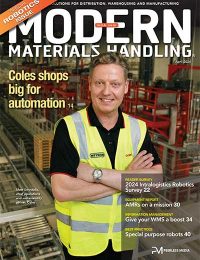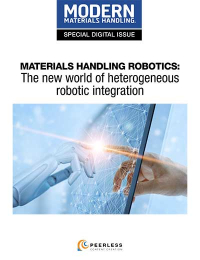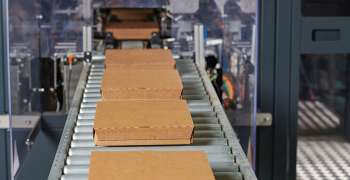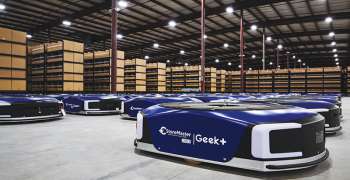Q&A at the CSCMP conference with XPO’s Brad Jacobs
Latest Material Handling News
LM Group News Editor Jeff Berman interviewed XPO Logistics Chairman and CEO Brad Jacobs at the Council of Supply Chain Management Professionals Annual Conference in Orlando this week. A transcript of the interview is below.
Logistics Management (LM): How are you viewing the current state of the freight economy, as well as the overall economy?
Brad Jacobs: It is hard to say, but my best guess is that we will continue to see sluggish growth for a little while longer. I don’t see any big reasons why growth is suddenly going to pick up in a [material] way. The good news is that things are not negative and are instead slightly positive.
LM: Looking at the truckload market and truckload brokerage in regards to things like capacity and pricing, how would you describe where things are in respect to both areas?
Jacobs: In the truckload business, volumes are still soft, pricing is stable to soft, and in order to optimize profits you need to focus on cost control. And that is exactly what we have been doing, optimizing the network and taking out unnecessary costs whenever necessary. We have to be competitive from a cost structure basis as well and are making good progress on that and also getting good synergies from the back office, technology, pricing, and our LTL business.
LM: Can you please provide some other examples of taking out costs?
Jacobs: The most important thing is increasing the utilization of the fleet and decreasing empty miles and using technology that we use in other parts of our business in order to program trucks in terms of where they should be. On the brokerage side of the house, the soft trucking market actually plays to our advantage, because the vast majority of our truckload brokerage business is on one-year contracts. We line up the freight one year at a time and cover the loads all year long on a monthly basis. The market has been soft so we have been the beneficiaries of that trend.
LM: What about on the spot market side?
Jacobs: Volume is not as strong in the spot market, and the routing guides are holding up very well. In fact, usually the first provider in the routing guide is taking the load more often than not and does not even get to the second or third provider. This is a byproduct of the current capacity environment. There is a lot of capacity and not a lot of freight, with people in the routing guides taking loads.
LM: With the electronic logging device mandate rolling out in late 2017, what do you think the effects of it will be on the truckload market in regards to rates and capacity, when it kicks in?
Jacobs: It will take out single-digit percentage of capacity, which is a lot, and a big swing. It will come out through very small fleets that already have razor-thin profits. The compliance forced by ELDs will probably result in a large exodus of those small fleets. In meeting with high level representatives of some of our global supply chain customers in North America, the conversations are less about RFPs coming out for specific lanes and modes and are more about the entire supply chain a shipper has and all the modes they are using and seeing if there are ways we can take out tens of millions of dollars in cost of their global supply chain[s], which is what we love to do and is what we live for. It is a great opportunity to really partner in a true sense with very large shippers and understand their needs and bring our expertise to bear and bring together a multimodal team of solution providers. That new method of doing business is resonating and gaining traction with shippers.
LM: How are you seeing the impact of e-commerce on supply chain operations and how things are changing and evolving in regards to warehousing and distribution, too?
Jacobs: Almost a quarter of our business is retail/e-tail so e-commerce is a big part of our business and the fastest growing part of our business in the U.S, Europe, and Asia. It is clearly a megatrend, and we are the largest e-fulfillment provider in Europe, and we are growing at twice the rate of their markets. And a big part of our U.S. supply chain business is geared towards e-commerce customers; it’s a huge growth engine. We have made a big bet on e-commerce, and it is paying off.
LM: How do you view the potential impact of the Presidential election on the markets you serve and how it relates to trade as well?
Jacobs: One of the most relevant issues for transportation is what happens to Mexico? We have around $800 million of cross-border business with Mexico mainly for intermodal, and it is a big part of our trucking business as well. If that candidate that is going to build a wall gets in, I hope there is a way to get through it to let trucks and trains in.
LM: From a customer perspective, what are things they are currently keen on, given the uneven economic landscape and demand patterns? Is it a need for more advanced technology or increased collaboration?
Jacobs: There is almost an insatiable appetite on our customers’ part for more and more advanced technology, and we are providing that as it provides an edge against the competition. We have 1,500 full-time IT professionals at XPO and spend more than $400 million per year investing in IT, so we are constantly innovating and coming up with cutting edge technology solutions for our customers all across the spectrum for transportation and contract logistics.
LM: How are the integrations of Con-way and Norbert Dentressangle going?
Jacobs: Both are going very well, and the positive numbers reflect that. The nitty gritty of the integrations are largely behind us. We are very good at integration and have a large group of people that are very experienced in integration for IT, HR, financial accounting, and more, which is all a big help in the integration process. Where we are now for both of these is in optimization for transferring best practices amongst the 750 warehouse facilities we have, cross-fertilizing engineered standards for the highest level of productivity and efficiency for our 450 cross-dock facilities on a global basis, managing our working capital better, making our technology systems globally more uniform, integrating with our customers technology so that they can have more visibility into what we are doing for them and we can have more visibility into their supply chain so we can help them. That is where we are in integration now. It is improving the network that we’ve got. We have an amazing global network that has leading positions in almost every important part of the supply chain, and we are just getting better and better every day.

Article Topics
News & Resources
Latest in Materials Handling
Registration open for Pack Expo International 2024 Walmart chooses Swisslog AS/RS and software for third milk processing facility NetLogistik partners with Vuzix subsidiary Moviynt to offer mobility solutions for warehouses Materials Handling Robotics: The new world of heterogeneous robotic integration BSLBATT is looking for new distributors and resellers worldwide Lucas Watson appointed CSO for Körber’s Parcel Logistics business in North America Hyster recognizes Dealers of Distinction for 2023 More Materials HandlingAbout the Author
Subscribe to Materials Handling Magazine

Find out what the world's most innovative companies are doing to improve productivity in their plants and distribution centers.
Start your FREE subscription today.
April 2024 Modern Materials Handling

Latest Resources










